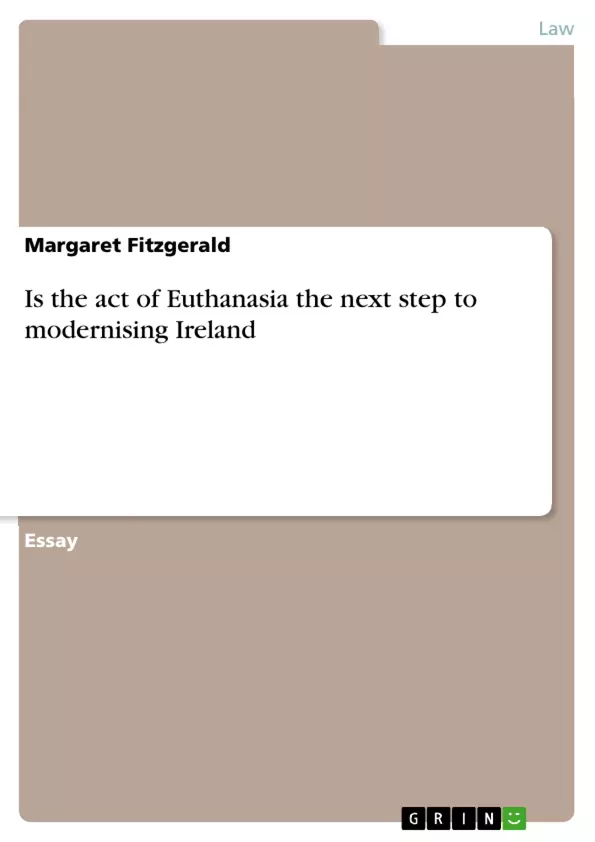It is important that the acts of Euthanasia and Assisted Suicide are legalised within the Republic of Ireland as it would be yet another stepping stone towards modernising Ireland.
Inhaltsverzeichnis (Table of Contents)
- Is the act of Euthanasia the next step to modernising Ireland?
- The Fleming Case
- John Stuart Mills's Utilitarianism
- Kant's Philosophy
- Regulating Euthanasia and Assisted Suicide
- Oregon Death with Dignity Act
- Euthanasia Legislation in the Netherlands
- England and Wales
- Statistics on Euthanasia and Assisted Suicide
- Concerns and Arguments Against Euthanasia and Assisted Suicide
Zielsetzung und Themenschwerpunkte (Objectives and Key Themes)
This essay examines the legal and ethical considerations surrounding Euthanasia and Assisted Suicide in Ireland, drawing upon international case studies and philosophical perspectives to explore the potential benefits and risks associated with these practices.
- The Case of Marie Fleming and the Right to Die with Dignity
- The Philosophical Foundations of Euthanasia and Assisted Suicide: Utilitarianism and Kantian Ethics
- International Legal Frameworks and Regulations for Euthanasia and Assisted Suicide
- Statistical Analysis and Public Opinion on Euthanasia and Assisted Suicide
- Potential Concerns and Ethical Dilemmas Surrounding Euthanasia and Assisted Suicide
Zusammenfassung der Kapitel (Chapter Summaries)
- The essay begins with a discussion of the legal situation surrounding Euthanasia and Assisted Suicide in Ireland, focusing on the landmark case of Marie Fleming. The case highlighted the complexities of navigating the intersection of individual rights, legal restrictions, and the societal debate on end-of-life choices.
- The essay then explores the philosophical justifications for Euthanasia and Assisted Suicide, examining the principles of utilitarianism and Kantian ethics as they relate to individual autonomy and the pursuit of happiness.
- To gain international context, the essay examines existing legal frameworks and regulations for Euthanasia and Assisted Suicide in countries like the Netherlands and the United States, particularly the Death with Dignity Act in Oregon. This analysis aims to demonstrate the possibility of enacting and implementing regulations effectively, thereby mitigating potential concerns and safeguarding patient rights.
- The essay delves into statistical data concerning the frequency of Euthanasia and Assisted Suicide in various countries, highlighting the prevalence of these practices and addressing potential concerns about abuse or coercion.
- Finally, the essay concludes with a nuanced discussion of the ethical and societal concerns surrounding Euthanasia and Assisted Suicide. It acknowledges the legitimate anxieties of the public and medical professionals regarding the potential for abuse and vulnerable patients being pressured into making unwanted choices. However, the essay argues that a careful examination of the evidence and the development of robust regulations can effectively address these concerns.
Schlüsselwörter (Keywords)
The essay focuses on key themes such as the right to die with dignity, individual autonomy, the morality of Euthanasia and Assisted Suicide, legal frameworks and regulations, international case studies, philosophical justifications, and societal perspectives on end-of-life choices.
- Quote paper
- Margaret Fitzgerald (Author), 2018, Is the act of Euthanasia the next step to modernising Ireland, Munich, GRIN Verlag, https://www.grin.com/document/439420



